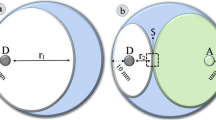Abstract
A strain of Bacillus subtilis was examined for antifungal activity against phytopathogenic and wood-surface contaminant fungi. The bacterium was grown in five culture media with different incubation times in order to study cell development, sporulation, and the production of metabolites with antifungal activity. The anti-sapstain and anti-mould activity of the bacterium grown in yeast extract glucose broth (YGB) medium in wood was also evaluated. In YGB, the bacterium inhibited the growth of several fungi and displayed a broader spectrum of activity than in the other media tested. A relationship between bacterial spore production and the formation of metabolites with antifungal activity was detected. YGB medium displayed effective control in wood block tests. YGB medium was extracted with solvents of increasing polarity and the dry residues were applied to silicagel plates, resolved with the appropriate solvent and sprayed with different solutions, detecting the presence, of amines, and higher alcohols. The bioautographic method revealed the presence of at least two active compounds against the blue-stain fungus Cladosporium cucumerinum.



Similar content being viewed by others
References
Benko R (1988) Bacteria as possible organisms for biological control of blue stain. International Research Group on Wood Preservation. Doc. No IRG/WP/1339, pp 1–12
Benko R, Highley TL (1990) Selection of media for screening interaction of wood-attacking fungi and antagonistic bacteria. Mater Org 25:173–180
Berger F, Li H, White D, Frazer R, Leifert C (1996) Effect of pathogen inoculum, antagonist density, and plant species on biological control of Phytophthora and Pythium damping-off by Bacillus subtilis Cot1 in high-humidity fogging glasshouse. Phytopathology 86:428–433
Bruce A (1998) Biological control of wood decay. In: Bruce A, Palfreyman JW (eds) Forest products biotechnology. Taylor and Francis, London, pp 251–266
Chitarra SG, Breeuwer P, Nout RJM, Van Aelst CA, Rombouts MF, Abee T (2002) An antifungal compound produced by Bacillus subtilis YM 10-20 inhibits germination of Penicillium roqueforti conidiospores. J Appl Microbiol 96:159–166
Cho SJ, Lee SK, Cha BJ, Kim YH, Shin KS (2003) Detection and characterization of the Gloeosporium gloeosporioides growth inhibitory compound iturin A from Bacillus subtilis strain KSO3. FEMS Microbiol Lett 223:47–51
Fiddaman PJ, Rossal S (1994) Effect of substrate on the production of antifungal volatiles from Bacillus subtilis. J Appl Bacteriol 76:395–405
Freitas JR, Germida JJ (1991) Pseudomonas cepacea and Pseudomonas putida as winter wheat inoculants for biocontrol of Rhizoctonia solani. Can J Microbiol 37:780–784
Greaves H (1970) The effects of selected bacteria and actinomycetes on the decay capacity of some wood-rotting fungi. Mater Org 5:265–279
Homans LA, Fuchs A (1970) Direct bioautography on thin-layer chromatograms as a method for detecting fungitoxic substances. J Chromatogr 51:323–327
Jack R, Tagg WRJ, Ray B (1995) Bacteriocins of Gram-positive bacteria. Microbiol Rev 59:171–200
Jacquiot C (1968) Antagonistic action of bacteria against fungi and its role in the preservation of pulpwood chips. BWPA Annual Convention 1468:1–3
Katz E, Demain A (1977) The peptide antibiotics of Bacillus: chemistry, biogenesis and possible functions. Bacteriol Rev 41:449–474
Leifert C, Li H, Chidburee S, Hampson S, Workman S, Sigee D, Epton HAS, Harbour A (1995) Antibiotic production and biocontrol activity by Bacillus subtilis CL27 and Bacillus pumillus CL45. J Appl Bacteriol 78:97–108
Morales L, Dickinson DJD (1998) A study of the factors governing the performance of preservatives used for the prevention of sapstain on seasoning wood with regard to the establishment of European standards: overview of co-operative project and development of laboratory test methods. In: Biology and prevention of Sapstain. Forest Products Society, Madison, Wis., pp 77–85
Nunes L, Silva A, Nobre T (2001) FAIR CT98-3689. Sustainable wood; new clean technology methods for the control of fungal stain in wood. Periodic report III. LNEC, Technical Report 26/2001. NM, Lisbon
Payne C, Bruce A, Staines H (2000) Yeast and bacteria as biological control agents against fungal discolouration of Pinus sylvestris blocks in laboratory-based tests and the role of antifungal volatiles. Holzforschung 54:563–569
Podile A, Prakash A (1996) Lysis and biological control of Aspergillus niger by Bacillus subtilis AF1. Can J Microbiol 42:533–538
Rishbeth J (1963) Stump protection against Fomes annosus III. Inoculation with Peniophora gigantea. Ann Appl Biol 52:63–77
Seifert K, Hamilton EW, Breuil C, Best M (1987) Evaluation of Bacillus subtilis C186 as a potential biological control of sapstain and mould on unseasoned lumber. Can J Microbiol 33:1102–1107
Silva AA, Morrell JJ (1998) Inhibition of wood-staining Ophiostoma picea by Bacillus subtilis on Pinus ponderosa sapwood. Mater Org 32:241–252
Acknowledgements
This work was supported by Fundação de Ciência e Tecnologia and by FEDER. Project 391647BSE/2001.
Author information
Authors and Affiliations
Corresponding author
Rights and permissions
About this article
Cite this article
Feio, S.S., Barbosa, A., Cabrita, M. et al. Antifungal activity of Bacillus subtilis 355 against wood-surface contaminant fungi. J IND MICROBIOL BIOTECHNOL 31, 199–203 (2004). https://doi.org/10.1007/s10295-004-0133-x
Received:
Accepted:
Published:
Issue Date:
DOI: https://doi.org/10.1007/s10295-004-0133-x




